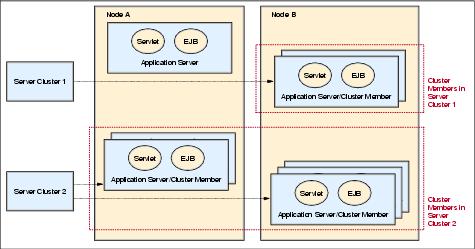6.4 WebSphere Application Server clustering
A cluster is a set of application servers that are managed together and participate in workload management. Application servers participating in a cluster can be on the same node or on different nodes. A network deployment cell can contain no clusters, or have many clusters depending on the need of the administration of the cell. The cluster is a logical representation of the application servers. It is not necessarily associated with any node, and does not correspond to any real server process running on any node. A cluster contains only application servers, and the weighted workload capacity associated with those servers.
The cluster member template is created when the first member is added to the cluster. Subsequent configuration changes to the first member will not affect the template, which will be used when creating more members. When creating a cluster, it is possible to select an existing application server as the template for the cluster without adding that application server into the new cluster (the chosen application server is used only as a template, and is not affected in any way by the cluster creation).
Cluster members can be added to a cluster in various ways, during cluster creation and afterwards. During cluster creation, one existing application server can be added to the cluster or one or more new application servers can be created and added to the cluster. There is also the possibility of adding additional members to an existing cluster later on. Depending on the capacity of your systems, you can define different weights for the various cluster members.
Cluster members are required to have identical application components, but they can be sized differently in terms of weight, heap size, and other environmental factors. You must be careful though not to change anything that might result in different application behavior on each cluster member. This concept allows large enterprise machines to belong to a cluster that also contains smaller machines, albeit of different weights.
Starting or stopping the cluster starts or stops all cluster members automatically and changes to the application are propagated to all application servers in the cluster.
Figure 6-3 shows an example of a possible configuration that includes server clusters. Server cluster 1 has two cluster members on node B only. Server cluster 2, which is completely independent of server cluster 1, has two cluster members on node A and three cluster members on node B. Finally, node A also contains a free-standing application server that is not a member of any cluster.

Figure 6-3 Server clusters and cluster members
| xxxx |